AMD Radeon HD 7870 GHz Edition & Radeon HD 7850 Review: Rounding Out Southern Islands
by Ryan Smith on March 5, 2012 12:01 AM ESTOverclocking: Power, Temp, & Noise
As with the rest of Southern Islands, AMD is making sure to promote the overclockability of their cards. And why not? So far we’ve seen every 7700 and 7900 card overclock by at least 12% on stock voltage, indicating there’s a surprising amount of headroom in these cards. The fact that performance has been scaling so well with overclocking only makes overclocking even more enticing. Who doesn’t want free performance?
So how does Pircairn and the 7800 series stack up compared to the 7700 and 7900 series when it comes to overclocking? Quite well actually; it easily lives up to the standards set by AMD’s previous Southern Islands cards.
| Radeon HD 7800 Series Overclocking | ||||
| AMD Radeon HD 7870 | AMD Radeon HD 7850 | |||
| Shipping Core Clock | 1000MHz | 860MHz | ||
| Shipping Memory Clock | 4.8GHz | 4.8GHz | ||
| Shipping Voltage | 1.219v | 1.213v | ||
| Overclock Core Clock | 1150MHz | 1050MHz | ||
| Overclock Memory Clock | 5.4GHz | 5.4GHz | ||
| Overclock Voltage | 1.219v | 1.213v | ||
Overall we were able to push our 7870 from 1000MHz to 1150MHz, representing a sizable 15% core overclock. This is now the 3rd SI card we’ve hit 1125MHz or 1150MHz – the other two being the 7970 and the 7770 – so AMD’s overclocking headroom has been extremely consistent for their upper tier cards.
As for memory overclocking, we hit 5.4GHz on both cards before general performance started to plateau, representing a 12.5% memory overclock. Considering that both cards use the same RAM on the same PCB, and the performance limitation is the memory bus itself, this is consistent with what we would have expected. With that said, we are a bit surprised that we got so far over 5GHz on 2Gb GDDR5 memory chips only rated for 5GHz in the first place; it indicates that Hynix’s GDDR5 production very mature.
With that said, because of the unique and non-retail nature of the 7850 AMD supplied us, the 7850 overclocking results should be considered low-confidence. The retail 7850 cards will be using simpler and no doubt cheaper coolers, PCBs, and VRMs; all of these can reduce the amount of overclocking headroom a card has. It’s by no means impossible that a 7850 could hit 1050MHz/5.4GHz, but it’s far more likely on a 7870 PCB than it is on a 7850 PCB.
Anyhow we’ll take a look at gaming performance in a moment, but in the meantime let’s take a look at what our overclocks do to power, temperature, and noise.
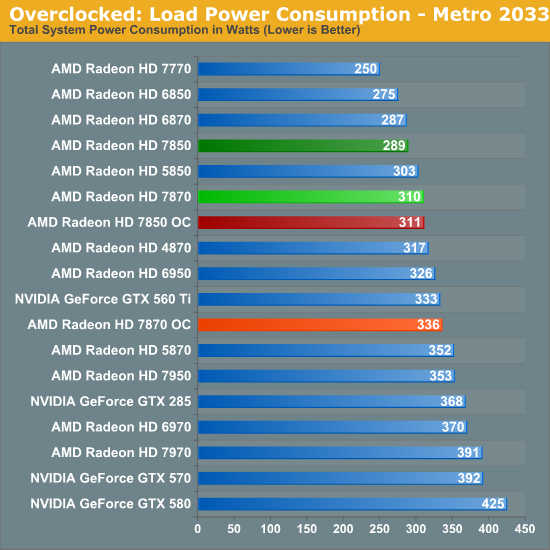
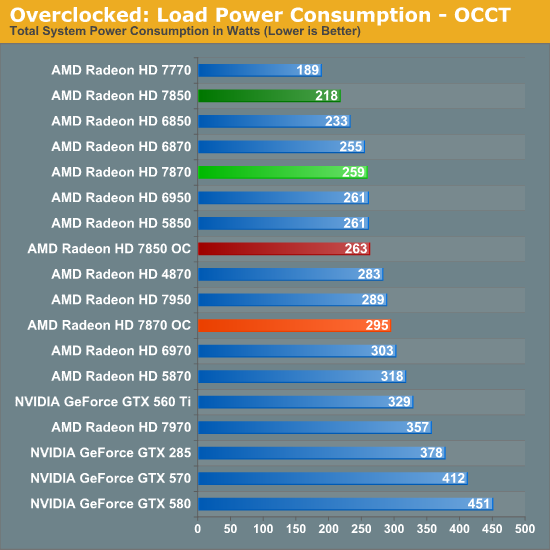
Even without a voltage increase overclocking does cause power consumption to go up, but not by a great deal. Under Metro the total difference is roughly 21W for the 7850 and 25W for the 7870, at least some of which can be traced back to the increased load on the CPU. Whereas on OCCT there’s a difference of nearly 40W on both cards, thanks to the increased PowerTune limits we’re using to avoid any kind of throttling when overclocked. All things considered with our overclocks power consumption for the 7850 approaches that of the 7870 and the 7870 approaches the GTX 560 Ti, which as we’ll see is a fairly small power consumption increase for the performance increase we’re getting.
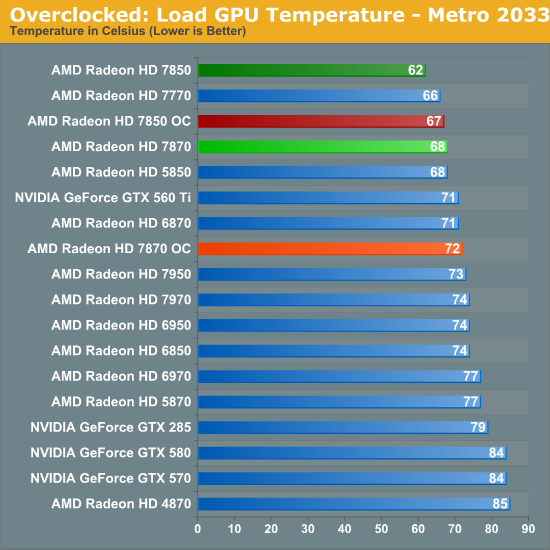
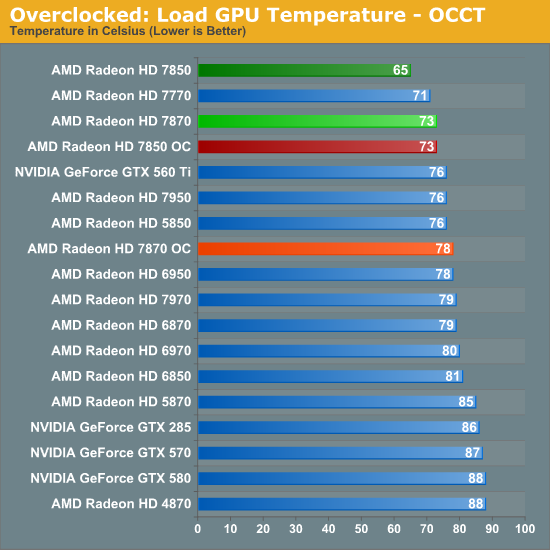
Of course when power consumption goes up so does temperature. For both cards under Metro and for the 7870 under OCCT this amounts to a 5C increase, while the 7850 rises 8C under Metro. However as with our regular temperature readings we would not suggest putting too much consideration into the 7950 numbers since it’s using a non-retail design.
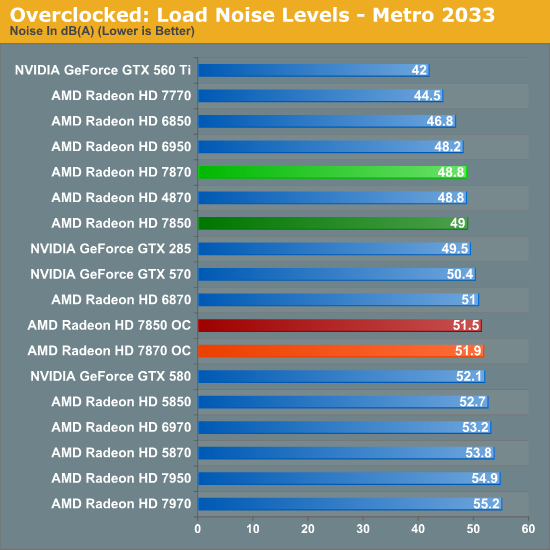
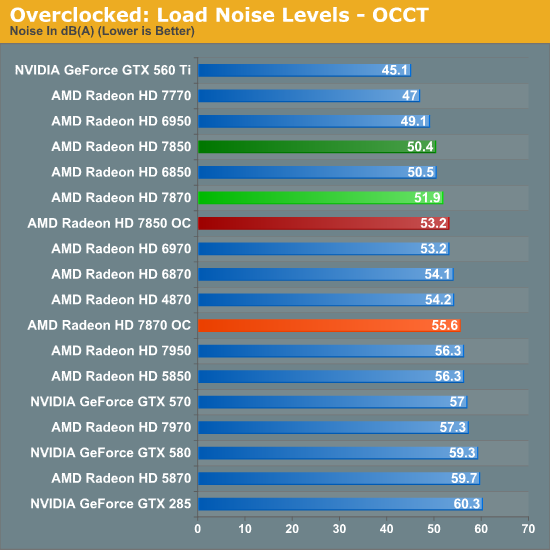
AMD’s conservative fan profiles mean that what are already somewhat loud cards get a bit louder, but in spite of what the earlier power draw differences would imply the increase in noise is rather limited. Paying particular attention to Metro 2033 here, the 7870 is just shy of 3dB louder at 51.9dB, while the 7850 increases by 2.7dB to 51.5dB. OCCT does end up being worse at 2.8dB and 3.7dB louder respectively, but keep in mind this is our pathological case with a much higher PowerTune limit.










173 Comments
View All Comments
rburnham - Monday, March 5, 2012 - link
I tend to skip one or two generations of video cards before upgrading, but the 7850 looks like a fairly respectable upgrade over my current 6850. I love that low power draw, although I might wait until someone like MSI comes out with a quieter version.CeriseCogburn - Thursday, March 8, 2012 - link
Your 6850 is 2 watts higher power draw at idle. But you're a gamer, so load draw is important. The 7850 is 14 watts higher power draw on normal load, and 26 watts more on high load. Powertune slider only increases that.smoka - Monday, March 5, 2012 - link
A lot of people are saying power draw is not important, but it is for some of us upgrading. I have been running a GTX460 for about a year now and I'm finally thinking about jumping on the Eyefinity bandwagon. I was eying the 6950 a few weeks ago, but I decided to wait for the 78xx to come out. My plan is to move to a single card and run at a lower resolution (3072x768 or 3840x1024) until I can upgrade to a CF setup and run at 5760x1080.Also keep in mind that I have a 600W PSU, which would need an upgrade a 69xx CF or GTX570/580 SLI setup. Many people who are in the mid-high end gaming market (which the 78xx is aimed at) don't have a 1000W PSU. Upgrading to these top-tier PSUs is also another expense to add to an already expensive graphics card overhaul.
The 7870 series fits the bill exactly for me, except for the $350 price-point. I really wanted the it to be priced at $300 or less. I am hoping it will hit this price either due to brand competition, store promotion, or after kepler release.
kallogan - Monday, March 5, 2012 - link
Actually i care about power consumption more than stupid power hungry raw performance.You are not responsible citizens when buying nvidia stuff. Buy amd and save the planet.
HAHA
compvter - Monday, March 5, 2012 - link
Sure performance/price matters most, but what i find interesting in current amd generation cards is zerocore that allows me to keep my computer running with low power draw when i don't use it. I don't really care about power draw when i am using computer, but i do care about noise, and those are kind of related. Still most of the cards are silent enough for me, but most of the time my coputer is on idle (or long idle) with software running that i can't turn off (irc client), so zerocore would save me a lot of money compared to Nv offerings. Still i am interested to see what nv offers, but at the moment im considering 7870 to replace my 3870x2. Would go 79xx, but don't want to buy new case =/mattgmann - Monday, March 5, 2012 - link
save the planet...lol. Though saving on the electricity bill would be nice. The power hungry 4890 tandem in my rig surely adds a few tens of dollars a month to my bill.pieguy - Monday, March 5, 2012 - link
In the paragraph about 7800 series voltage, you mention 7950 voltages but I think you mean 7850 voltage, else I am not understanding...Also, a question about these voltages of 1.213 - 1.219. I don't know much on the subject. If these are the voltages under load, what are they actually set to (before vdroop)? If this voltage is standard for these cards, does it mean that we shouldn't be concerned about using this voltage on other 28nm 7XXX series cards for extra OC headroom and 24/7 usage? I'm just trying to figure out a max "safe" 24/7 voltage for my 7950 since the overclocking scales really well with voltage increases.
Thanks for the great review!
Ryan Smith - Monday, March 5, 2012 - link
Hi Pie, thanks for the correction. As for the voltages, those are the VIDs, so it's without vdroop. As for what a safe voltage is, there's no easy answer to that. Though 1.21v is likely safe for 7900 cards that are already in the 1.17v range.ObeseMaurice - Monday, March 5, 2012 - link
I bought a 2GB 6950 2 weeks ago for $240 and $20 mail in rebate. The 7870 is worse on all resolutions of Battlefield 3 and priced significantly higher. Very unimpressive product launch from AMD.silverblue - Monday, March 5, 2012 - link
Has anybody stopped to think how much extra performance you might get from these cards when AMD has proper drivers for them, or is this considered a moot point? Needless to say, nowhere on the BF3 benchmarks in this review is the 7870 slower than the 6950, rather it's a consistent 20% faster. Throughout the review the 7870 ranges from about 15% (Batman 1920x1200) - 70% (Civ5 1920x1200) faster depending on the title. Granted, the gap isn't always this large at 2560x1600 but it's still sizeable in a good number of cases. Are you in fact referring to the 7850?AMD are pricing these cards at that level because they can. It's certainly not going to last forever.